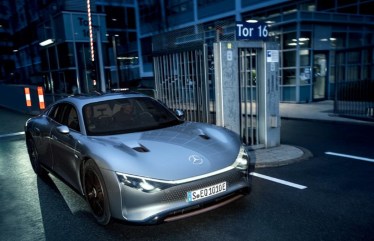The VISION EQXX from Mercedes-Benz has demonstrated its range and efficiency in Europe, traveling from Sindelfingen to its destination of Cassis on the Côte d’Azur. The EQXX covered more than 1,000 km (621 miles) in everyday traffic, on a single battery charge.
The journey was undertaken at regular road speeds, including prolonged fast-lane cruising at up to 87 mph on the German autobahn and near the speed limit elsewhere. The battery’s state of charge on arrival was around 15 percent, amounting to a remaining range of around 140 kilometers (87 miles), and the average consumption was 8.7 kWh per 100 kilometers (7.1 kWh per 62 miles).
The VISION EQXX is the most efficient Mercedes ever built. The technology program behind it marks a milestone in the development of electric vehicles. It underpins our strategic aim to ‘Lead in Electric’,” says Ola Källenius, Chairman of the Board of Management of Mercedes-Benz Group AG.
The EQXX uses carbon-fiber-sugar composite material for the upper part of the battery, which is also used in Formula 1, and the BIONEQXXTM rear floor is manufactured using an aluminum casting process.
The light metal structural component replaces a much heavier assembly of several interconnected parts. It has gaps in places where structural strength is not required, thus saving material. This design approach results in a weight saving of up to 20 percent compared to a conventionally manufactured component.
A large part of the weight efficiency is also due to the dedicated electric chassis with a lightweight F1 subframe and aluminum brake discs. Another is the battery. At 100 kWh, the power storage unit developed specifically for the VISION EQXX has almost the same amount of energy as the battery of the EQS.
However, it has 50 percent less volume and is 30 percent lighter. The outcome is that the compact battery, measuring just 200 x 126 x 11 cm (79 x 50 x 4 in), is also comparatively light at 1,091 lbs and fits in a compact car. The electric drive was developed in cooperation with the experts from Mercedes-AMG Petronas F1 Team.
The VISION EQXX regenerates its energy reserves. In electric cars, this is called recuperation, the recovery of braking energy. The VISION EQXX can use the recuperation effect on any type of gradient and during every braking maneuver, thus extending its range.
A positive side effect of this electric braking is that the mechanical brakes are barely used. This makes it possible for the first time to use new types of aluminum brake discs that weigh significantly less than their steel counterparts.
The VISION EQXX gets an energy refresh – not at the charging station, but via its fixed solar roof. The 117 solar cells feed the 12-volt battery, which supplies power to auxiliary consumers such as the navigation system. The solar booster increases the range by more than two percent – which adds up to 25 kilometers (16 miles) on a journey of over 1,000 kilometers (621 miles).
Since the electric drivetrain generates minimal heat waste, passive cooling is sufficient throughout the journey. The cooling plate in the underbody uses airflow to ensure even cooling. This aerodynamic solution increases the range by 20 kilometers (12 miles), while the cd value remains unchanged at a low 0.17. The air control system would only open an additional airpath if there is an increased demand for cooling the electric drive or for climate control inside the cabin on hot days or if the heat pump is running on cold days.
The airpath then connects the high-pressure zone at the front of the vehicle with the low-pressure zones along the top of the hood. This enables thermal management with minimal air resistance. With the shutters open, the cd value would increase by only seven points (0.007).
The VISION EQXX also proves to be an intelligent sidekick, assisting the driver like a co-pilot with tips on the best possible driving style. The efficiency assistant provides information on energy flow, battery status, topography, and even the direction and intensity of wind and sun.
The UI/UX features an all-new, one-piece display that spans the entire width of the interior. Elements of the user interface support seamless interaction between the driver and the vehicle. These include Artificial Intelligence (AI) which mimics the way the human brain works. In the VISION EQXX, Mercedes-Benz takes a new UI/UX approach.
VISION EQXX: the technical data at a glance
| Energy content of the battery | kWh | < 100 |
| Rated voltage | volts | > 900 |
| Energy consumption | kWh/100 km (miles/kWh) | 8.7 (7.1) |
| Cd value | 0.17 | |
| Front face | m² | 2.12 |
| Power | kW | 180 |
| Wheelbase | in | 110 |
| Length/width/height | in | 196/74/53 |
| Unladen vehicle weight | lbs | 3,869 |
